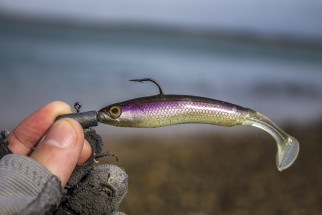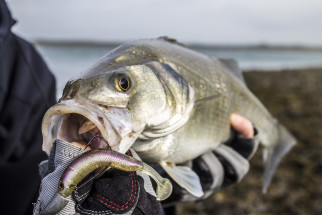Quite often lure anglers are looking for longer rods and more aerodynamic lures to cast further and cover more water in the hope that it will increase the odds of encountering a bass – sounds logical! In fact, sometimes it is a must in order to reach features or structure which lurk at the outer limits of our casting ability but let’s turn things around for a minute and look at what happens under our toes.
I’ve been guilty of the above in the past but on a few trips last season I had my eyes opened to the amount of times I would spook bass around the margins – especially in back bays and estuaries. So with this in mind I decided to switch tactics and leave the long range kit at home and adopt a more subtle approach … it was time for ninja bassing!
The areas I was targeting were weedy margins which gave way to pebbles and sand patches. I had spent a few sessions watching to see when and where the bass liked to lurk and my conclusion was to wait until the tide had lifted the weeds until they were standing up straight and spreading a little on the surface. This created good cover underneath and threw plenty of shadows for the bass to lie in ambush.

I witnessed a few fish lying up under the weeds in the slack and darting out into the edge of the current to nail some helpless sand eels – so it was time to formulate a strategy.
I geared up with a short, 7ft rod rated 5-21g and sorted out a few soft lures around the 3.8″ to 4.5″ range with a mix of open point and weedless jig heads between 5g to 10g.

The plan was to stay fairly low, keeping a distance back from the edge so not to spook the lurking bass, then flick the lure just up past the weed and twitch it back. The theory all sounded good but being low and back from the edge meant that I can virtually see none of what my lure was doing … it was all down to feel!
I could sense every movement of the small shad as the tail vibrated on the fall and then the tap as the jig head hit the sand or a pebble and then … whack! Fish on!
Immediately I stood up to get better leverage on the fish and to ensure it didn’t foul me up in the weeds … It wasn’t a big bass but it didn’t matter when you execute a plan!

After a quick scrap it was time to release the fish and to my surprise instead of heading out to the current it simply nipped back under the weeds … obviously a place of sanctuary and safety as well as a feeding zone.
It all clicked into place nicely! In fairness though, I had spent a few hours watching and waiting to simply observe how the bass moved about undisturbed … Granted you can not always see the fish but in this case the water is clear and quite shallow. My trusty pair of Costa Del Mar Rooster with 580 G lenses helped cut surface glare and certainly made it a lot clearer to see what was going on a few feet below.

So a bit of food for thought for 2017 maybe? I know it has certainly made me re-think how I tackle some areas I fish and perhaps this season you may see a different approach to my bassing than before … Certainly something to contemplate while we sit here waiting for the weather to improve.
Tight Lines,
Steve
©Images and text by Steven Neely.
Want to get published? Click here
Gear used in this article :
Illex Element Rider, S 210 M, 5-21g (Stalking Special)
Daiwa Certate 3012 Hi-Speed
Illex Nitro PE Braid, 16lb
YGK Nitlon FC, 16lb (Attached using FG knot)
Decoy Bachi (7g) / Owner Ultra Head (10g) / Illex Texas Jig (5g)
Illex Glossy Shad 3.8″ (Shiny Wakasagi)
Illex Super Pintail 4″ (Noike Shad)
Megabass X Layer 4.5″ (AYU)
Lunker City Sluggo 4.5″ (Smelt)
Costa Del Mar Rooster, 580 G (Blue Mirror / Grey Lens)
Camera used Nikon AW 1